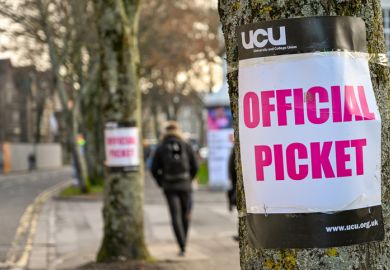The focus of the Universities Superannuation Scheme dispute so far has been on the short-term recovery plan.
Should benefits take the form of defined contributions, determined solely by market returns, or defined benefits, in which payouts retain a link to salaries?
This debate has stolen attention from discussion of a long-term settlement that will be necessary to underwrite secure pensions for members and certainty for employers.
The most problematic feature of the current Universities UK proposal is the reduction, to 13.25 per cent, in the employer contribution to future accrual of benefits. An additional 4.75 per cent of salary will go towards other costs and, in the short term, servicing the existing debt.
As a result, the cost of the increased deficit falls entirely on the employee, via reduction of future benefits, which is entirely against the spirit of the 2011 agreement to share future costs. But, equally significantly, 13.25 per cent sets a benchmark that will potentially result in significantly reduced overall contributions over the long term.
This is important because there is a strong argument that the current problems stem directly from the decision by employers in 1996 to reduce their contributions from 18.55 per cent to 14 per cent.
In short, the most important element of any settlement would be a long-term (20-year) commitment by employers to continue to fund the scheme at least at the current level of 18 per cent of salary.
With this level of funding secured for the long term, the scheme would be more resilient to those aspects over which both employers and employees have little control, such as short-term economic factors and valuation methodologies.
This would allow negotiations about benefits, and in particular the defined benefits/defined contributions split, to be held in a climate where both parties have the common goal of providing the most attractive possible package for members.
The offer by UUK to continue funding the scheme at the current level (18 per cent of salary) until 2023 is a start.
But it also suggests that they might consider reducing that contribution in the not-too-distant future. There is the precedent of the reduction of employer contribution in 1996, which was justified by the argument that it did not lead to a reduction in benefits.
In this current situation, once the deficit has been cleared (possibly as early as 2023) the employers may well argue that they can again reduce their contribution to 16 per cent (or lower) without loss of benefits, having established a defined contribution rate of 13.25 per cent as the norm.
As others have stated, we believe that the current valuation takes an unnecessarily pessimistic view of the funding of the USS as an ongoing scheme.
This is driven by current actuarial practice, encouraged by a hawkish pensions regulator whose only real obligation appears to be to avoid taxpayer bailouts.
Nonetheless, the current regulatory framework and the pressures to de-risk conspire to ensure that returns from a defined benefit scheme are likely to be less attractive than they have been in the past.
In a fully funded scheme such as the USS, both defined benefit and defined contribution benefits are sensitive to market conditions. In each crisis, the defined benefit benefits are eroded to ensure affordability, but there appears to be no real mechanism (or at least no appetite among the employers) to increase them when market conditions allow, so that the risks of weak investment performance are arguably just as great for defined benefit as for defined contribution.
If the history of the past 10 years of the USS teaches us anything, it is that external pressures (in this case from low interest rates and gilt yields) are just as much of a threat to defined benefit as they are to defined contribution.
It is legitimate for USS members to ask why we should believe any commitment from the employers to contribute at least 18 per cent in the long term.
It is, in our view, very much easier to defend a level of contribution than a level of benefit.
We can reasonably only ask university leaders to manage those elements over which they have control. As far as the USS is concerned, that is the amount of salary that they invest in the scheme (across its various elements). They have little or no control over actuarial methodology, inflation, the economy, or life expectancy.
Given the history, it is easy to imagine a future in which employer contributions are steadily eroded, member contributions grow and benefits decrease.
We have real concerns that by focusing on a watered-down defined benefit scheme at present, rather than focusing on the extent of contribution, irrespective of the scheme, we will allow the employers to get away with a proposal that will result in further cuts in future.
A 20-year commitment by the employers would be a significant sign of good faith that would underwrite the health of the fund and form a strong basis to work together for the benefit of all USS members.
Jon Forster, Graham Niblo and James Vickers are based at the University of Southampton’s department of mathematical sciences. All three write in a personal capacity.
Register to continue
Why register?
- Registration is free and only takes a moment
- Once registered, you can read 3 articles a month
- Sign up for our newsletter
Subscribe
Or subscribe for unlimited access to:
- Unlimited access to news, views, insights & reviews
- Digital editions
- Digital access to THE’s university and college rankings analysis
Already registered or a current subscriber?




